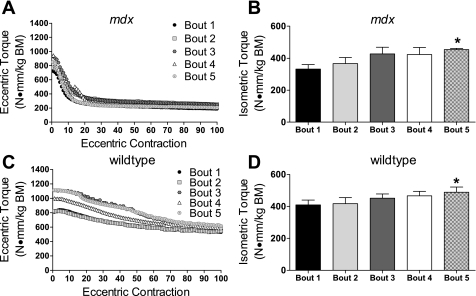Fig. 5.
Maximal posterior crural muscle torques for bouts 1–5 for mdx (A and B) and wild-type (C and D) mice. A: peak eccentric torque generated by the posterior crural muscles during bouts 1–5 for mdx mice. There was no difference in torque loss during the injury protocol across bouts (P = 0.543). B: preinjury peak isometric torque of the posterior crural muscle from mdx mice improved across bouts. C: peak eccentric torque generated by the posterior crural muscle during bouts 1–5 for wild-type mice. There was no difference in eccentric torque loss during the injury protocol across bouts (P = 0.206). D: preinjury peak isometric torque of the posterior crural muscles from wild-type mice improved across bouts. *P ≤ 0.025, bout 5 > bout 1. All data are means ± SE. Error bars not seen are contained within the symbol.

